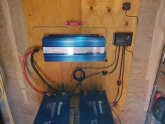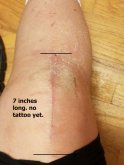D
You are using an out of date browser. It may not display this or other websites correctly.
You should upgrade or use an alternative browser.
You should upgrade or use an alternative browser.
svetz
Works in theory! Practice? That's something else
Nice workmanship! What's the red gizmo above the inverter? Are those ground wires?
The fuse isn't for normal usage; it's for abnormal usage. So, don't think of it as 500w. Think of it as a short from a wrench getting dropped across two wires and welding itself in place so it can't be removed. That's what happens when Scotty yells...She's gonna blow!...I know I need a fuse between the batteries and the inverter, but is it critical if I'm only using 500w or so? ...
svetz
Works in theory! Practice? That's something else
I'm thinking you'll need a fuse to go with it  It was the one negative comment on amazon. It's rated for 300 amps, so good for 3600W at 12V.
It was the one negative comment on amazon. It's rated for 300 amps, so good for 3600W at 12V.
If you're a hobbyist and love this stuff, you might also think about a meter and shunt so you can measure current flows.
Absolutely not needed, but a nice cool-factor when you're showing it off.
Just saw in your post about those stiff cables... <sigh> should probably write something up on minimum bend radius. yeah, they do make "extra-flexible" battery cables, never used them though.
If you're a hobbyist and love this stuff, you might also think about a meter and shunt so you can measure current flows.
Absolutely not needed, but a nice cool-factor when you're showing it off.
Just saw in your post about those stiff cables... <sigh> should probably write something up on minimum bend radius. yeah, they do make "extra-flexible" battery cables, never used them though.
Last edited:
Rider
Solar Addict
I used some flexible 4 gauge jumper cables. Thin strand, super flexible. I use the clamp end as connectors for a spare battery.yeah, they do make "extra-flexible" battery cables, never used them though.
svetz
Works in theory! Practice? That's something else
How'd they work out? Any unexpected gotchas?I used some flexible 4 gauge jumper cables. Thin strand, super flexible. I use the clamp end as connectors for a spare battery.
Rider
Solar Addict
Worked fine. I like to solder my connections instead of crimp, and the insulation started to melt as I heated it with the torch (cheap coating), but it all gets covered up with shrink tubing anyway.How'd they work out? Any unexpected gotchas?
Rider
Solar Addict
Rider
Solar Addict
Well, 12VDC x 300A = 3600W. If you surge beyond 3600W, chances are it will pop. Size the fuse for your MAX amps draw. If you surge to 4000W, the fuse should be no less than 333A, plus fudge factor, so 350A. If you size to the maximum possible surge of 6000W, that's 500A plus fudge, as you have stated.I selected the 300 amp fuse based on the rated input for the inverter. Should I go bigger to cover surge wattage up to 6,000 watts (500 amps)?
Rider
Solar Addict
There's nothing to stop you from running more than one wire, double it up if needed. Lower cost, easier to manipulate. 2 wires each carrying 250A each is still 500A. Just need 2 fuses, one on each wire.Seems like it should be 500a if I want to use all of the inverter, and according to the charts I'm looking at, I still need 4/0 wire at that amperage and it may not even be enough?
Rider
Solar Addict
BTW folks, this also works for wiring from the panel to the SCC. Running 3 pairs of 12 gauge wire can handle 60 amps, that's 1440W at 24VDC, 720W at 12VDC. Just need to use a couple of small buss bars on each end.There's nothing to stop you from running more than one wire, double it up if needed. Lower cost, easier to manipulate. 2 wires each carrying 250A each is still 500A. Just need 2 fuses, one on each wire.
svetz
Works in theory! Practice? That's something else
No, the sigh was me realizing I had more work to do ;-) There's more verbiage on the bottom of the wiring page in the Beginner's Corner now (although Rider might be cursing me).I guess by the "sigh", I made a rookie mistake.
svetz
Works in theory! Practice? That's something else
Usually breakers/fuses won't trip on surges as they are very short durations. General rule of thumb is to upsize 125% of expected current.Seems like it should be 500a if I want to use all of the inverter, and according to the charts I'm looking at, I still need 4/0 wire at that amperage and it may not even be enough?
Don't worry if the wire is bigger than what you need, lower losses that way.
If the fuse holder is rated for 300 amps, a 500 amp fuse isn't a good idea.
Rider
Solar Addict
No, the sigh was me realizing I had more work to do ;-) There's more verbiage on the bottom of the wiring page in the Beginner's Corner now (although Rider might be cursing me).
svetz
Works in theory! Practice? That's something else
I'm not saying it's logical... but it was the bit on wire bendingView attachment 213 About what? I don't see anything I'd question...
Rider
Solar Addict
Oh, you didn't like my pretzel wire? lol.I'm not saying it's logical... but it was the bit on wire bending
Rider
Solar Addict
My OCDness really want's all the bends at 90 degrees, Physics & NEC regulations can sometimes make you want to
But the pretzel likeness is a nice testimony to it's flexibility.
Why are you using fuses? You can have the same protection from a circuit breaker that can be reset or it can be used as a disconnect to work on your system. Your house has circuit breakers (unless it was built in the 1950's) they do the same job of protecting the circuits and are easier to reset.
Both inverter batteries should not be on the same battery...
You want loads to pull from balanced sides. Connecting to the same battery, will off balance the cels.
Opposite for charging them as well.
You want loads to pull from balanced sides. Connecting to the same battery, will off balance the cels.
Opposite for charging them as well.
eddie1261
Solar Enthusiast
Similar threads
- Replies
- 6
- Views
- 483
- Replies
- 0
- Views
- 211





